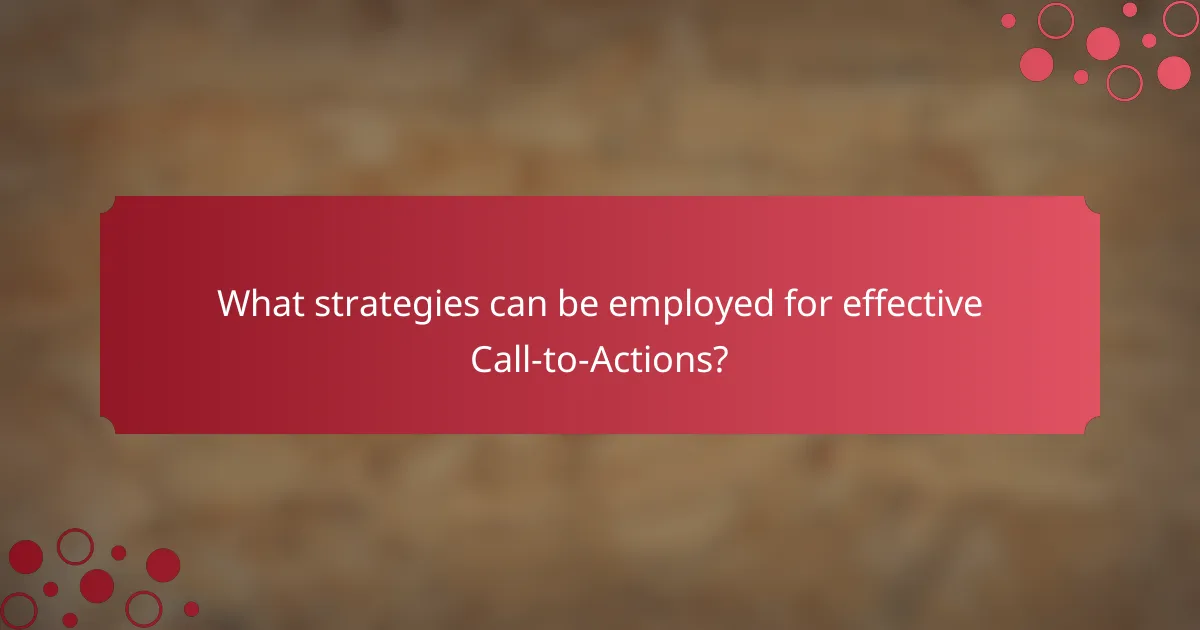Call-to-Actions (CTAs) are essential web design elements that prompt users to take specific actions, such as signing up or making a purchase. This article outlines effective strategies for crafting CTAs, emphasizing the importance of clarity, urgency, strategic placement, eye-catching design, and personalization. It also discusses best practices for testing CTAs, including A/B testing and user behavior analysis, to optimize their effectiveness. Research indicates that well-designed and strategically placed CTAs can significantly enhance conversion rates, making them a critical component of successful web design.

What are Call-to-Actions in Web Design?
Call-to-Actions (CTAs) in web design are prompts that encourage users to take specific actions. They are typically presented as buttons or links. CTAs guide users towards desired outcomes, such as signing up, purchasing, or downloading content. Effective CTAs use clear, actionable language and stand out visually on the page. Research shows that well-designed CTAs can significantly increase conversion rates. For example, a study by HubSpot found that personalized CTAs can lead to a 202% increase in conversion rates. This demonstrates the importance of strategically placing and designing CTAs within a website.
How do Call-to-Actions influence user behavior?
Call-to-Actions (CTAs) significantly influence user behavior by guiding them towards specific actions. Effective CTAs increase conversion rates by creating a sense of urgency and clarity. For instance, a study by HubSpot found that personalized CTAs perform 202% better than basic CTAs. This demonstrates the importance of tailoring CTAs to user preferences. Additionally, CTAs placed strategically on a webpage can lead to higher engagement rates. Research indicates that buttons with contrasting colors can improve visibility and click-through rates. Overall, well-crafted CTAs are essential for driving desired user actions on websites.
What psychological principles underpin effective Call-to-Actions?
Effective Call-to-Actions (CTAs) are underpinned by several psychological principles. These principles include scarcity, urgency, social proof, and reciprocity. Scarcity creates a sense of limited availability, prompting quicker decision-making. Urgency encourages immediate action by suggesting time constraints, often leading to higher conversion rates. Social proof leverages the influence of others’ actions, showing that many users have engaged with the CTA. Reciprocity fosters a sense of obligation by providing value upfront, increasing the likelihood of a positive response. Research indicates that CTAs designed with these principles can significantly enhance user engagement and conversion rates. For instance, a study by Cialdini (2009) highlights how scarcity and urgency can effectively motivate consumer behavior.
How do emotions play a role in Call-to-Actions?
Emotions significantly influence Call-to-Actions (CTAs) by driving user engagement and decision-making. Emotional triggers can create a sense of urgency or connection. For instance, using words like “now” or “limited” evokes urgency, prompting immediate action. Additionally, positive emotions such as happiness or excitement can enhance the likelihood of clicking a CTA. Research indicates that emotionally charged language increases conversion rates by up to 20%. When users feel a personal connection to a message, they are more likely to respond favorably. Therefore, incorporating emotional elements into CTAs is essential for effective web design and user interaction.
Why are Call-to-Actions essential for web design?
Call-to-Actions (CTAs) are essential for web design because they guide users toward desired actions. CTAs help improve conversion rates by directing visitors to take specific steps. Effective CTAs increase user engagement by making navigation intuitive. Research shows that well-placed CTAs can boost click-through rates by up to 300%. Clear and compelling CTAs enhance user experience by providing clarity on next steps. They also help in achieving business goals by transforming visitors into leads or customers. The absence of CTAs can lead to confusion and decreased site effectiveness. Thus, integrating CTAs is crucial for successful web design.
What impact do Call-to-Actions have on conversion rates?
Call-to-Actions (CTAs) significantly influence conversion rates. Effective CTAs guide users toward desired actions, such as making a purchase or signing up for a newsletter. Research indicates that well-designed CTAs can increase conversions by up to 200%. Clarity, urgency, and visibility are essential attributes of successful CTAs. For example, using action-oriented language can improve user engagement. A/B testing different CTA designs can reveal which versions yield the highest conversion rates. Overall, CTAs are crucial in optimizing user experience and driving conversions.
How do Call-to-Actions enhance user experience?
Call-to-Actions (CTAs) enhance user experience by guiding users towards desired actions. They provide clear instructions, making navigation intuitive. Effective CTAs reduce confusion about what to do next. They can increase engagement by prompting users to interact with content. Research shows that well-placed CTAs can boost conversion rates significantly. For example, a study by HubSpot found that personalized CTAs convert 202% better than generic ones. This demonstrates the impact of tailored CTAs on user experience. Overall, CTAs streamline user journeys and improve satisfaction.
What are the different types of Call-to-Actions?
The different types of Call-to-Actions (CTAs) include buttons, links, forms, and banners. Buttons are often the most prominent CTAs, encouraging immediate action. Links can be embedded in text to guide users subtly. Forms collect user information and facilitate engagement. Banners attract attention and can promote offers or subscriptions. Each type serves a unique purpose in web design, enhancing user interaction and conversion rates.
What are the characteristics of a strong Call-to-Action?
A strong Call-to-Action (CTA) is clear, compelling, and actionable. It uses concise language that conveys urgency. Effective CTAs often include verbs that prompt immediate action, such as “Buy Now” or “Sign Up Today.” A strong CTA is visually distinct, often utilizing contrasting colors to stand out. It is strategically placed within the design, ensuring visibility without being intrusive. Additionally, a strong CTA aligns with user intent and offers a clear benefit. Research indicates that CTAs with personalized messaging can increase conversion rates significantly. For example, a study by HubSpot found that personalized CTAs perform 202% better than generic ones.
How do different types of Call-to-Actions serve various goals?
Different types of Call-to-Actions (CTAs) serve various goals by targeting specific user behaviors. For instance, ‘Sign Up’ CTAs encourage user registration, increasing the user base. ‘Buy Now’ CTAs drive immediate sales, directly impacting revenue. ‘Learn More’ CTAs facilitate user education, guiding potential customers through the sales funnel. ‘Subscribe’ CTAs aim to build an email list, enhancing future marketing efforts. Each CTA type is crafted to elicit a distinct response aligned with business objectives. Research shows that tailored CTAs can increase conversion rates by up to 202% (HubSpot, 2023). This demonstrates the effectiveness of using different CTAs to meet specific goals in web design.

What strategies can be employed for effective Call-to-Actions?
Effective Call-to-Actions (CTAs) can be achieved through several strategies. First, clarity is essential. A clear message informs users exactly what action to take. Second, urgency can drive immediate responses. Phrases like “limited time offer” encourage quick decisions. Third, placement matters. Positioning CTAs above the fold increases visibility. Fourth, design should be eye-catching. Using contrasting colors makes CTAs stand out. Fifth, personalization enhances engagement. Tailoring messages to user preferences can boost conversion rates. Finally, A/B testing allows for optimization. Testing different versions helps identify the most effective CTAs. These strategies are supported by industry research, which indicates that well-placed and designed CTAs can increase conversion rates by up to 200%.
How can language and tone be optimized in Call-to-Actions?
Language and tone in Call-to-Actions (CTAs) can be optimized by using clear, action-oriented verbs. This encourages immediate engagement from the audience. Phrases like “Get Started” or “Join Now” create a sense of urgency. Tailoring the language to match the target audience’s preferences enhances relatability. For instance, using casual language for a younger demographic can increase effectiveness. Additionally, incorporating emotional triggers can motivate users to act. Words that evoke excitement or curiosity can drive higher conversion rates. Testing different phrases through A/B testing provides data on what resonates best. According to a study by HubSpot, personalized CTAs can increase conversion rates by 202%. This evidence supports the importance of language and tone in optimizing CTAs.
What are the best practices for writing compelling Call-to-Actions?
Compelling Call-to-Actions (CTAs) should be clear, concise, and action-oriented. Use strong verbs that convey urgency, such as “Get,” “Start,” or “Join.” Position CTAs prominently on the page to ensure visibility. Utilize contrasting colors to make CTAs stand out. Personalize CTAs to resonate with the target audience, enhancing engagement. Test different wording and designs to determine what performs best. According to a study by HubSpot, personalized CTAs can increase conversion rates by 202%. Use A/B testing to refine CTAs based on performance data.
How does urgency affect the effectiveness of Call-to-Actions?
Urgency significantly enhances the effectiveness of Call-to-Actions (CTAs). It creates a psychological pressure that motivates users to act quickly. When users perceive a time constraint, they are more likely to engage with the CTA. Research shows that CTAs with urgency can increase conversion rates by up to 300%. Phrases like “Limited time offer” or “Act now” trigger immediate responses. This tactic leverages the fear of missing out (FOMO). Marketers often use countdown timers to visually reinforce urgency. Such strategies lead to higher click-through rates and improved sales.
What design elements contribute to successful Call-to-Actions?
Successful Call-to-Actions (CTAs) rely on several key design elements. First, color significantly impacts visibility and user engagement. Research shows that using contrasting colors can increase click-through rates by up to 21%. Second, the size of the CTA button must be large enough to attract attention but not overwhelming. A study indicates that larger buttons can enhance interaction rates. Third, clear and compelling text is essential. Action-oriented language like “Get Started” or “Sign Up Now” promotes urgency. Fourth, strategic placement is crucial; CTAs should be positioned above the fold or at natural stopping points in content. Fifth, whitespace around CTAs enhances focus and reduces distractions. Lastly, incorporating visual cues, such as arrows or icons, can guide users toward the CTA. These design elements collectively contribute to the effectiveness of CTAs in web design.
How does color choice influence Call-to-Action effectiveness?
Color choice significantly influences Call-to-Action (CTA) effectiveness. Different colors evoke specific emotions and responses in users. For instance, red can create urgency, while blue often conveys trust. Studies show that using contrasting colors makes CTAs stand out, increasing visibility. A/B testing indicates that changing a button’s color can lead to conversion rate variations of up to 21%. Additionally, colors aligned with branding can enhance recognition and engagement. Research by HubSpot found that colored CTAs can boost click-through rates by 200%. Therefore, strategic color selection is crucial for optimizing CTA performance.
What role does button placement play in Call-to-Actions?
Button placement significantly influences the effectiveness of Call-to-Actions (CTAs). Proper placement can enhance visibility and encourage user interaction. Research indicates that buttons placed above the fold receive more clicks. A study by EyeTrackShop found that users focus on the upper part of a webpage first. Additionally, buttons positioned near relevant content can increase conversion rates. For instance, CTAs placed next to product descriptions lead to higher engagement. Clear and strategic placement guides users toward desired actions. Thus, button placement is crucial for optimizing CTAs in web design.
How can personalization enhance Call-to-Actions?
Personalization enhances Call-to-Actions (CTAs) by making them more relevant to individual users. Tailored CTAs resonate with specific audience segments. This increases engagement and conversion rates. For instance, personalized CTAs can lead to a 202% increase in conversion rates, according to HubSpot. Additionally, users are more likely to respond to CTAs that reflect their past behavior or preferences. By addressing users by name or suggesting products based on previous purchases, CTAs become more compelling. This targeted approach creates a sense of connection. Ultimately, personalization improves the effectiveness of CTAs in driving desired actions.
What data can be used to inform personalized Call-to-Actions?
User behavior data can be used to inform personalized Call-to-Actions. This includes metrics such as click-through rates, time spent on page, and scroll depth. Demographic data also plays a crucial role. Information like age, gender, and location can tailor messages effectively. Additionally, past purchase history provides insights into user preferences. A/B testing results help refine Call-to-Actions based on user responses. Engagement metrics, such as shares and comments, indicate content resonance. All these data points contribute to creating targeted and effective Call-to-Actions.
How does user segmentation affect Call-to-Action strategies?
User segmentation significantly influences Call-to-Action (CTA) strategies. By dividing users into distinct groups based on characteristics, marketers can tailor CTAs to meet specific needs. This approach increases the relevance of CTAs, leading to higher engagement rates. For instance, a study by HubSpot found that personalized CTAs perform 202% better than generic ones. Segmenting users allows for targeted messaging, which resonates more with each group. Different segments may respond better to varying designs, wording, or placement of CTAs. Thus, user segmentation is essential for optimizing the effectiveness of CTAs in web design.

What are the best practices for testing Call-to-Actions?
The best practices for testing Call-to-Actions (CTAs) include A/B testing, analyzing user behavior, and optimizing placement. A/B testing compares two versions of a CTA to determine which performs better. This method provides clear data on user preferences. Analyzing user behavior involves tracking clicks and conversions to understand how users interact with CTAs. This analysis helps identify effective designs and messaging. Optimizing placement means testing different locations on the webpage to see where CTAs receive the most engagement. Research shows that CTAs placed above the fold generally perform better, as users see them without scrolling.
How can A/B testing be utilized for Call-to-Actions?
A/B testing can be utilized for Call-to-Actions (CTAs) by comparing two variations to determine which performs better. This involves creating two versions of a CTA, such as different text, colors, or placements. Each version is shown to a segment of users, and their interactions are measured. Metrics such as click-through rates or conversion rates provide data on performance. For example, a study found that changing a CTA button color increased clicks by 21%. This method allows designers to make data-driven decisions, optimizing CTAs for higher engagement and effectiveness.
What metrics should be measured during A/B testing of Call-to-Actions?
The metrics that should be measured during A/B testing of Call-to-Actions (CTAs) include click-through rate, conversion rate, bounce rate, and engagement metrics. Click-through rate measures the percentage of users who click on the CTA compared to the total number of users who viewed it. Conversion rate tracks the percentage of users who complete the desired action after clicking the CTA. Bounce rate indicates the percentage of visitors who leave the page without interacting further. Engagement metrics assess how users interact with the CTA, including time spent on the page and scroll depth. These metrics provide valuable insights into the effectiveness of different CTA designs and placements.
How do you interpret the results of A/B tests for Call-to-Actions?
To interpret the results of A/B tests for Call-to-Actions, analyze the conversion rates of each variant. The variant with the higher conversion rate is typically considered more effective. Track metrics such as click-through rates, engagement levels, and overall conversions. Statistical significance should be established to ensure results are not due to random chance. Use tools like confidence intervals to measure this significance. Consider the sample size; larger samples provide more reliable data. Evaluate user feedback for qualitative insights. This combination of quantitative and qualitative analysis leads to informed decisions on optimizing Call-to-Actions.
What tools are available for testing Call-to-Actions?
A variety of tools are available for testing Call-to-Actions (CTAs). A/B testing tools like Optimizely and VWO allow users to compare different CTA versions. Heatmap tools such as Hotjar and Crazy Egg provide insights on user interactions with CTAs. Analytics platforms like Google Analytics track CTA performance metrics. User feedback tools, including Qualaroo, gather qualitative data on CTA effectiveness. These tools help optimize CTAs for better conversion rates.
What features should you look for in Call-to-Action testing tools?
Look for features like A/B testing capabilities in Call-to-Action testing tools. A/B testing allows you to compare different versions of your CTA. This helps identify which version performs better. Another important feature is analytics integration. Analytics provide insights into user interactions with CTAs. Customization options are also crucial. They enable you to tailor CTAs to specific audiences. Additionally, user behavior tracking is essential. It helps understand how users engage with CTAs over time. Finally, reporting features are important. They summarize performance metrics for informed decision-making.
How can analytics improve Call-to-Action performance?
Analytics can improve Call-to-Action (CTA) performance by providing data-driven insights. These insights help identify which CTAs resonate with users. Analytics track user behavior, allowing for adjustments based on engagement metrics. For example, A/B testing reveals which CTA designs yield higher conversion rates. Metrics like click-through rates and conversion rates indicate the effectiveness of CTAs. By analyzing user demographics, businesses can tailor CTAs to specific audiences. Furthermore, heatmaps show where users click most frequently, guiding optimal CTA placement. According to a study by HubSpot, personalized CTAs can increase conversion rates by 202%.
What common pitfalls should be avoided when testing Call-to-Actions?
Common pitfalls to avoid when testing Call-to-Actions include lack of clarity, insufficient audience targeting, and ignoring analytics. Clear messaging in Call-to-Actions is essential for user understanding. If users do not understand what to do, they are less likely to engage. Targeting the wrong audience leads to ineffective tests. Without the right audience, results may not reflect true performance. Ignoring analytics can result in missed insights. Data-driven decisions are crucial for optimizing Call-to-Actions. Additionally, not testing variations can limit understanding of what works best. A/B testing different versions provides valuable comparisons. Finally, failing to consider user experience can negatively impact engagement. A seamless experience encourages users to follow through with actions.
How can misinterpretation of data affect Call-to-Action strategies?
Misinterpretation of data can significantly undermine Call-to-Action (CTA) strategies. When data is misread, it may lead to incorrect assumptions about user behavior. For instance, if analytics suggest low engagement, a team might mistakenly change the CTA too drastically. This could alienate existing users who prefer the original approach.
Additionally, misinterpretation can result in targeting the wrong audience. If demographic data is misunderstood, the CTA may not resonate with the intended users. This misalignment can lead to lower conversion rates.
Moreover, incorrect data analysis might cause neglect of effective CTAs that are already in place. Teams may abandon successful strategies due to perceived underperformance based on flawed data.
In summary, misinterpretation of data can lead to misguided decisions, ineffective targeting, and the loss of successful strategies in CTA implementation.
What are the consequences of neglecting user feedback in Call-to-Action testing?
Neglecting user feedback in Call-to-Action (CTA) testing can lead to ineffective design choices. This oversight may result in lower conversion rates. A study by HubSpot found that personalized CTAs can increase conversion rates by 202%. Without user insights, businesses may miss vital preferences or pain points. This can lead to wasted resources on untested assumptions. Additionally, ignoring feedback can harm user experience. Users may become frustrated with irrelevant or unclear CTAs. Ultimately, neglecting feedback stifles optimization opportunities. This can hinder overall marketing effectiveness and brand growth.
What are some practical tips for optimizing Call-to-Actions?
To optimize Call-to-Actions (CTAs), use clear and concise language. Effective CTAs should convey a strong message that prompts immediate action. Utilize contrasting colors to make CTAs stand out visually. Position CTAs prominently on the page, preferably above the fold for maximum visibility. Test different wording and designs to determine what resonates best with your audience. Incorporate urgency by using time-sensitive phrases like “limited time offer.” Analyze user behavior through A/B testing to refine CTA performance. Ensure CTAs are mobile-friendly, as a significant portion of users access websites via smartphones.
The main entity of the article is Call-to-Actions (CTAs) in web design, which are prompts designed to encourage user engagement and drive specific actions such as purchases or sign-ups. The article outlines effective strategies for crafting CTAs, including the importance of clarity, urgency, and personalization, as well as the psychological principles that enhance their effectiveness. It discusses various types of CTAs, their impact on conversion rates, and best practices for testing and optimizing their performance through A/B testing and analytics. Additionally, the article highlights common pitfalls to avoid and the crucial role of user feedback in refining CTAs for improved user experience and engagement.
